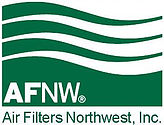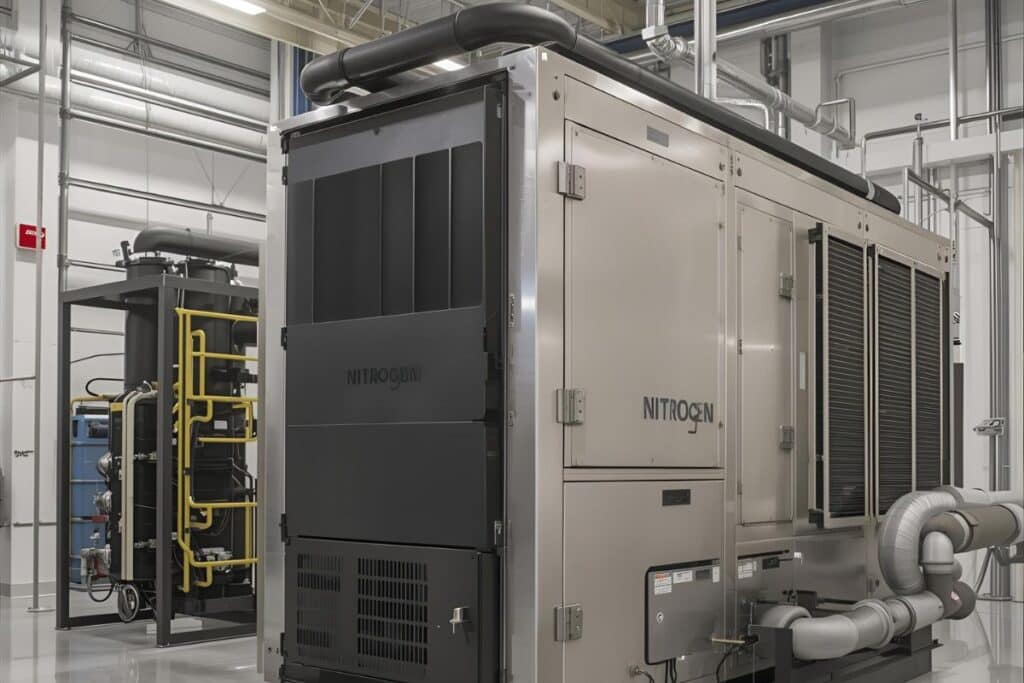About 78% of the air we breathe is nitrogen, but in factories, it’s a lot more than just background gas. Nitrogen is very important for maintaining operations steady, safe, and free of contamination in many industries, including food packaging, oil refining, aircraft welding, and semiconductor manufacturing.
Most facility managers don’t know how much the purity of nitrogen affects performance and expense. The difference between 99.5% and 99.9% purity can mean the difference between your product line running smoothly or having to deal with costly downtime and quality problems. It’s the thing that makes manufacturing go smoothly, keeps quality high, and cuts down on waste.
We’ll talk about why nitrogen purity is important, when more purity is necessary, how nitrogen is made on-site, and what to think about when picking the best nitrogen system for your facility in this post.
Why Nitrogen, and Why Purity Ratios Matter
The significance of nitrogen is clear: it doesn’t react, it stays dry, and it’s safe. But the word “nitrogen” on a spec sheet can signify different things for different uses. The amount of oxygen (and water vapor) left over in the gas stream is usually what determines purity. The less oxygen there is, the purer the nitrogen. For example:
- 95% N₂ → 5% residual oxygen
- 99.99% N₂ → 100 ppm O₂
- 99.999% N₂ → 10 ppm O₂
When you talk about residual oxygen, you commonly go from percentage notation to parts per million (ppm) when the purity level goes up. Industries use the terms “4-9s” or “5-9s” to describe high-purity grades (for example, 99.99% = four 9s). Why bother? A little bit of oxygen can destroy a process. For example, it can cause welds to rust, food to deteriorate, or semiconductor wafers to not work properly.
Typical Industry Purity Requirements (Quick Reference)
Different industries have different thresholds. Here are common, practical guidelines:
- Food & Beverage (MAP): ~99–99.5% nitrogen to displace oxygen and extend shelf life.
- Oil & Gas (inerting/purging): 95–99% is common for tank blanketing and pipeline purging.
- Laser Cutting / Metal Fabrication: 99.5–99.999% depending on cut quality and material thickness.
- Electronics & Semiconductors: 99.99–99.999% for soldering, wafer processing, and high-purity blanketing.
- Pharmaceuticals / Labs: 99–99.999% depending on the specific process and contamination sensitivity.
In short, the cleaner and more precision-sensitive the process, the higher the purity you’ll need.
How Industrial Nitrogen Gas is Produced
Cylinders (delivered), bulk/liquid deliveries, and on-site generation are the three main ways to get supplies. On-site solutions are becoming more popular since they save money, lower the risk of logistics problems, and let you customize the purity and flow to fit your needs.
Two common on-site technologies:
1. PSA (Pressure Swing Adsorption)
- Uses carbon molecular sieves (CMS) to trap oxygen while allowing nitrogen to pass.
- Typical purity range: 95% → 99.999% depending on design.
- Great for flexible purities and mid-to-high flows.
- It is widely utilized in industrial nitrogen gas applications because it is energy-efficient for greater purities and scales well.
2. Membrane systems
- Use selective membranes to separate oxygen and water vapor from air.
- Typical purity range: 95% → 99.5% (some advanced membranes approach 99.9%).
- Lower capital cost, simpler operation, ideal where very high purity is not required.
On-site generation saves a lot of money: many facilities pay 50–90% less for nitrogen than they would if they got it in cylinders or liquids. The return on investment is quick—usually less than two years—for businesses with consistent, predictable demand, like food packing lines, laser cut shops, and test labs.
High-purity nitrogen generator designs (PSA versions or hybrid systems) are the best solution if you need very low oxygen content (single-digit ppm).
Practical Examples: Where Purity Makes or Breaks The Job
- Laser cutting stainless steel: The lower purity makes the cut edge rust. You usually require 99.95–99.999% nitrogen at the right flow rates to get glossy, non-oxidized surfaces.
- Soldering/electronics: Even 50–100 ppm O₂ can make dross and weak joints, hence a lot of plants employ 99.999% nitrogen (10 ppm O₂) for important soldering operations.
- Food packaging (MAP): 99.5% nitrogen reduces oxidation and microbial growth to extend shelf life safely without wasting money on higher than necessary purity.
- Pipeline inerting/oil & gas: 95–99% nitrogen is usually enough to keep things from catching fire and stop corrosion.
Dewpoint and Dryness: Another Critical Purity Metric
For many industrial uses, moisture (dew point) counts as much as oxygen. Some uses, such as electronics, specialty polymers, and food freeze drying, need nitrogen with a dewpoint that is very low (as low as –70°C / –94°F or better). When you pick a pure nitrogen gas supply, make sure to check the oxygen ppm and dewpoint requirements.
Choosing Between Delivered Vs. On-Site Pure Nitrogen Gas
Ask yourself:
- How much N₂ do you use each day? High continuous consumption favors generation on-site.
- What level of purity and dew point do you need? Choose a PSA system that meets those requirements or a cryogenic supplier if you need a dewpoint of 99.999% and –60°C.
- How steady is your demand? Those who use a lot of different things at once might like cylinders better, while those who use a lot of the same thing all the time might like onsite savings.
- What are the expenses of safety and logistics? Getting rid of cylinder deliveries lowers the risk of handling them and makes more room for storage.
A high-purity nitrogen generator that is the right size can help you control purity and keep costs predictable. You can make N₂ when and where you need it.
ROI, Cost Drivers, and Real Numbers
Let’s talk money briefly — because good engineering always returns savings.
- Upfront: To start, a medium-sized industrial PSA generator might cost anywhere from tens of thousands to hundreds of thousands of dollars, depending on the flow and purity.
- Savings: Many purchasers say that when demand is stable, they pay 50–90% less per unit than they would for cylinder or liquid supplies.
- Operational gains: less downtime (no waiting for deliveries), fewer safety incidents when handling cylinders, and better product yields (fewer rejects) all add to the ROI.
- Purity trade-offs: going from 99.5% to 99.999% raises energy and capital costs. Only pay for the “9s” you really need.
In short: sizing matters. Overspecifying costs money, and underspecifying puts the quality of the product in danger. That’s why it’s important to do site surveys and flow/purity profiling.
Safety and Regulatory Considerations
Nitrogen is not reactive, yet it is dangerous because it displaces oxygen and can cause suffocation in small areas. Best ways to do things:
- Install oxygen monitors where nitrogen is used or stored.
- Vent exhaust and bleed lines safely.
- Train staff on confined-space and cylinder handling procedures.
- Maintain purge and emergency plans.
Include alarms, pressure reliefs, and O₂ monitors in your design review if you’re putting in a high-purity nitrogen generator.
The Air Filters Northwest Advantage
We have been serving facilities in the Pacific Northwest and beyond for more than 30 years. During that time, we have learned a lot more than just how to supply equipment. Our NAFA-certified technicians know how nitrogen systems work with the rest of your building.
We do thorough site surveys to find out exactly what you need, not what we want to sell you, but what will work best for your specific application. We build solutions that function, whether you require pure nitrogen gas for packaging food, industrial nitrogen gas for making things, or a high-purity nitrogen generator for making electronics.
Our warehouse, which is more than 12,500 square feet, has everything from basic nitrogen equipment to high-purity systems. We offer emergency services around the clock because we know that delays in the delivery of nitrogen can cost thousands of dollars every hour.
Optimize Your Nitrogen System with Air Filters Northwest
Nitrogen may be easy to understand, but its effects on product quality, safety, and pricing are not. The appropriate level of purity and the proper way to get it may make a big impact. They can cut down on waste, make things more consistent, and lower costs throughout your whole business.
If you’re ready to make your nitrogen setup more efficient or check how well it’s working now, call Air Filters Northwest at (503) 968-3261. Our experts will look at your purity needs, check how well your system is working, and help you discover the best long-term solution that will save you money.
FAQs
Q: What is “pure nitrogen gas”?
A: "Pure nitrogen gas" is N₂ with very few contaminants, which is usually measured in parts per million (ppm) or percent purity. For many industrial uses, "pure" denotes 99.9% or more; "ultra-high purity" requires 99.999%.
Q: What’s the difference between PSA and membrane nitrogen generators?
A: PSA uses molecular sieves to soak up oxygen and can get purities as high as 99.999%. Membrane systems separate gases by letting some through and not others. They usually get to 95–99.5% purity. Membranes are easier and less expensive, but they don't reach UHP levels.
Q: When do I need a high-purity nitrogen generator?
A: When your application needs oxygen levels in the single digits ppm, such as when you need to solder electronics, cut lasers for shiny edges, or do important lab work. You're in the high-purity range if your spec says it needs to be more than 99.99% pure.
Q: How do I know what nitrogen purity my application requires?
A: Different industries and uses have different purity requirements. Food packaging usually needs 99.5%, electronics soldering needs 99.999%, laser cutting needs 99.95–99.999%, and fire prevention devices work with 95–98%. Check with industry standards or get help from nitrogen experts to figure out what you need.
Q: How much can I save with on-site nitrogen generation?
A: Many facilities report 50–90% cost reductions versus cylinder or liquid supply, depending on flow stability, purity requirements, and local delivery costs.
Q: Is nitrogen dangerous?
A: Nitrogen is non-toxic and non-flammable, but can displace oxygen. Use oxygen monitoring and safe ventilation, especially in confined spaces.

